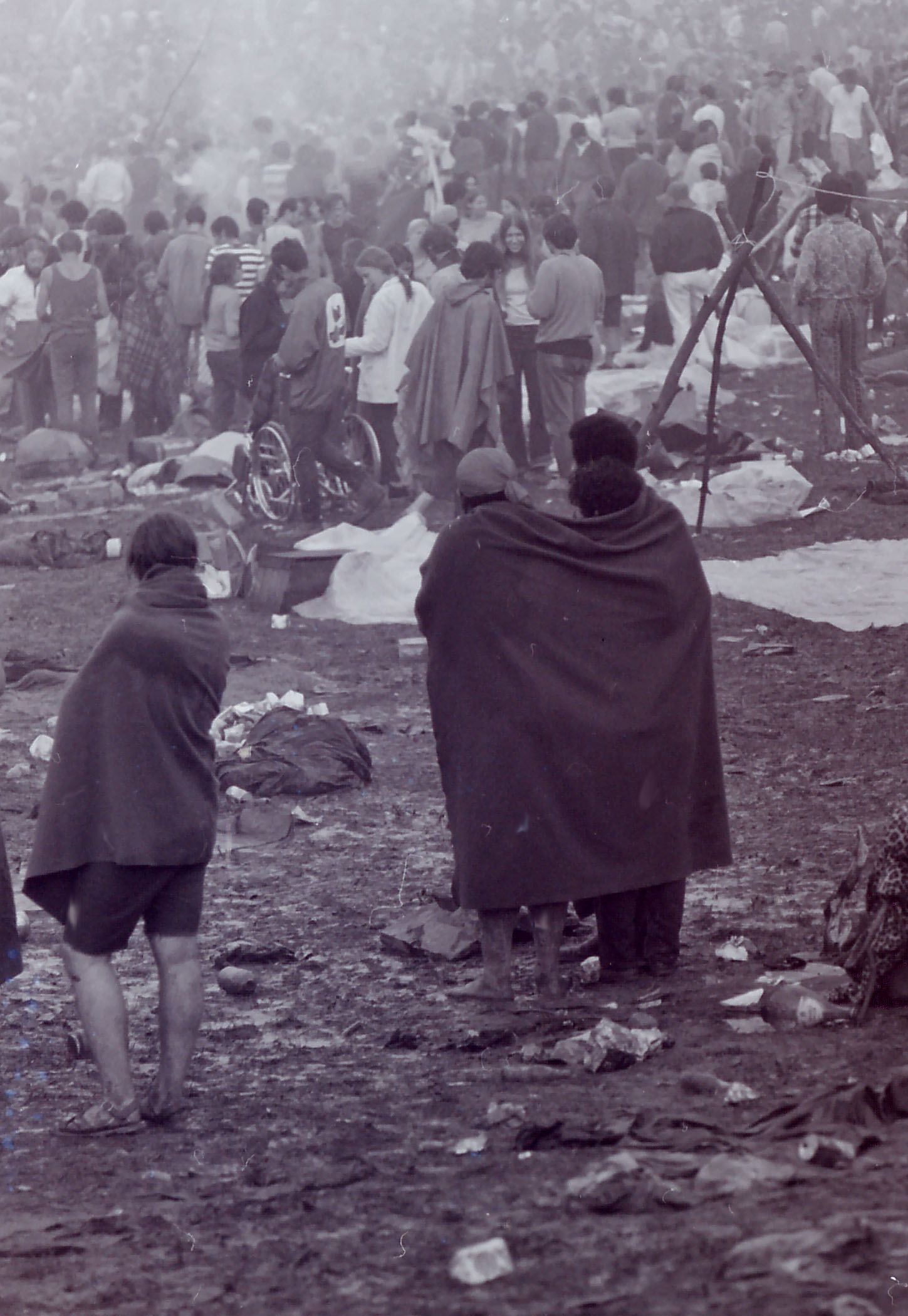For three days, a massive outdoor concert of a half-million listeners had reigned over an upstate New York dairy farm owned by Max Yasgur. Organizers for the Woodstock Music & Art Festival had chosen the farm for its natural bowl shape, perfect for acoustics. Originally the festival was to charge, but as funds ran dry and far more attendees appeared than expected, the organizers decided to skip setting up fences and security, instead focusing on readying the music.
The concert seemed on the brink of disaster from the beginning. With so many people, there was little or no access to food, water, or sanitation. Attendees camped or slept in the elements, much of which was rain over the course of the weekend. Yasgur's fields turned to giant mud pits. Despite the discomfort, or perhaps because of it, people embraced nature and enjoyed the concert featuring stunning performances by Santana, Grateful Dead, Creedence Clearwater Revival, Janis Joplin, The Who, Jefferson Airplane, Johnny Winter, and Jimi Hendrix.
As the concert came to a close in the wee hours of Monday morning, people began to pack up after listening to a wobbling rendition of the national anthem on Hendrix's guitar. According to various reports in the apocryphal film Woodstock, someone, somewhere, said, “Hey, this is groovy. Why do we have to leave?”
The idea spread through the crowd like wildfire. While thousands left the area, tens of thousands more stayed. A cluster seized the stage, declared it public property, and began something of an “open mic” day. John Roberts, one of the festival organizers, attempted to regain control with his crew of security guards, but they were booed, used as targets for rotten food, and finally beaten with various blunt instruments. Yasgur called the police, and the festival quickly escalated to a riot. New York Governor Nelson Rockefeller sent in 10,000 National Guard, as he had been prepared to do the day before when Roberts had calmed his fears. Now 10,000 scarcely seemed enough.
Journalists, who had been covering the massive traffic tie-ups throughout the weekend, covered the escalation live. The National Guard began to arrive as well as protesters from around the area. Evening settled, and the National Guard took up a siege of the farm, only to find themselves surrounded by more protesters pouring in from around the country, some having driven through the night from as far away as Missouri and Wisconsin. Thrown rocks and chants were traded with tear gas and rubber bullets. The riot spread to neighboring counties, and Rockefeller declared a wide state of emergency, inviting President Nixon to take charge of the wild situation.
Though later denied and subject of the investigation that would find Nixon impeached, ultimately resigning in 1971, the order was given to use live ammunition on the “damn hippies” that were “tearing up” the state of New York. Peace and love had fallen, conquered by blood and steel. Social upheaval would spread throughout the nation, causing sit-ins, demonstrations, and further riots, primarily centered around universities. At Kent State in Ohio, the fall semester would be broken up by further shootings, and calamity would spread anew throughout the country. The New Years' Bloodbath in San Francisco would result in the deaths of over one thousand rioters.
Nixon declared a state of emergency and began systematically to crack down on the counter-culture movement, even to the point of calling back troops from Vietnam. Curfews were enforced with heavy fines, substance control penalties were raised to military executions, and even dress and living codes were adopted to eliminate hippie culture. A “black list” of rock and roll songs was created, though immediately tied up in courts from the First Amendment. Over the course of 1970, America would become something of a police state. Gradually, the tempers would calm, and people began to cry out for peace or at least “some kind of sanity,” to quote journalist Walter Cronkite.
With elections in 1970, the government wrung itself out to establish moderate rule. Nixon and many others were put on trial, but many of their policies were kept with weaker punishments. In 1972, Democrat George McGovern won narrowly over Republican John Ashbrooke. In the following decade, the United States would turn away from international involvement and return to isolationism, praising the ideals of forefathers like George Washington and Thomas Jefferson.
International power shifted to the Soviet Union, which would overstretch itself in the late '70s and '80s with invasions of Afghanistan and Iran. The collapse of Soviets came in 1992, soon followed by the liberation of many dependencies, such as the reunited Germany of 1994. The world stood without a clear leader for more than a decade, but gradually the growing strength of the European Union came to shadow world policy. Many suggest the military successes of China in the '90s and early new millennium in the policing of Southeast Asia suggest it as the new superpower, but others doubt their lackluster economy with allow them sufficient clout.
–
In reality, the Woodstock Festival stood as one of the greatest moments in the Peace and Love movement. Despite the constant potential for violence, goers were more concerned with music and merriment. Farmer Max Yasgur, who did not rent his farm for another festival the next year, was nonetheless impressed by the hippies, saying that they “can turn those adversities that are the problems of America today into a hope for a brighter and more peaceful future.”

No comments:
Post a Comment